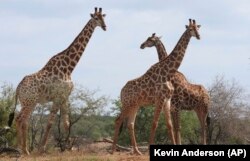An international wildlife conference has approved resolutions aimed at protecting endangered animal and plant species. It also heard about the illegal international trade that threatens their survival.
Delegates have been attending the conference this week in Geneva, Switzerland. They represent countries that signed an international agreement on trade in endangered species. It is called CITES, short for the Convention on International Trade in Endangered Species of Wild Fauna and Flora.
The United Nations reports that about 1 million animal and plant species are threatened and could disappear forever.
The conference approved resolutions aimed at protecting several species of shark and other animals, including the giraffe. The conference changed the trade rules for many wildlife species threatened by overfishing, overharvesting and overhunting. It also expanded the ability to fight illegal trade.
Ivonne Higuero is CITES’ Secretary-General. She told reporters that illegal traders are a serious problem. She praised the conference’s delegates.
“For example, you adopted decisions on strengthening enforcement efforts for tortoises and fresh water turtles. You will also support efforts to tackle illegal trade in the sub-regions of West and Central Africa. This illegal trade affects elephant ivory and species such as pangolins, parrots and rosewood.”
Higuero also praised the conference for establishing the CITES Big Cat Task Force. The task force, she said, has powers to improve enforcement, fight illegal trade and work with others on protecting tigers, lions, cheetahs, jaguars and leopards.
The illegal trade in wildlife is estimated to be worth up to $20 billion a year.
Added protection for giraffes
The move to protect giraffes brought praise from wildlife activists and criticism from some African countries.
Giraffes are only found in Africa. People often see these animals at zoos, and “think they are abundant,” notes Susan Lieberman of the Wildlife Conservation Society. “And in Southern Africa, they may be doing OK, but giraffes are critically endangered.”
Lieberman said that giraffes were mostly at risk in parts of West, Central and East Africa.
A leading African conservationist said the new protections could help stop giraffe population loss, as the move would help to document the number of giraffes.
“The giraffe has experienced over 40% loss in the last 30 years, noted Philip Muruthi of the African Wildlife Foundation. “If that…continues, it means that we are headed toward extinction.”
Not all African countries supported the move, however.
Maurus Msuha is director of wildlife at the Tanzanian Ministry of Natural Resources and Tourism. He said “Tanzania has a stable and increasing population of giraffes.”
CITES says the population of wild giraffes is actually much smaller than that of wild African elephants.
“We’re talking about a few tens of thousands of giraffes and we’re talking about a few hundreds of thousands of African elephants,” said Tom De Meulenaar, chief of scientific services at CITES.
“With fewer giraffes than elephants in Africa, it was a no-brainer to simply regulate giraffe exports,” said Tanya Sanerib. She is international legal director at the Center for Biological Diversity.
The United States is the world’s biggest buyer of giraffe products, conservationists said.
Sanerib said it was important for the U.S. government to act on its own. “It’s still urgent for the Trump administration to protect these…animals under the U.S. Endangered Species Act,” she said in a statement.
I’m Dorothy Gundy.
Lisa Schlein reported this story for VOANews.com. George Grow adapted her report. This report also includes information from an Associated Press story by Jamey Keaten. Mario Ritter Jr. was the editor.
_____________________________________________________________
Words in This Story
species – n. a group of animals or plants that are similar and can produce young animals or plants
adopt – v. to approve or accept; to take by choice
abundant – adj. plentiful
conservationist – n. a person who acts for the protection of wildlife and the environment
extinction – n. the state or situation that results when something (such as a plant or animal species) has died out completely
stable – adj. secure; strong or fixed
no-brainer – n. a simple decision that does not require a lot of thinking
Write to us in the Comments Section or on our Facebook page.











